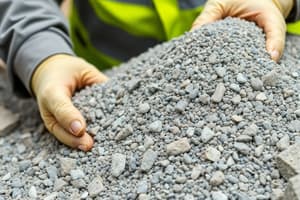Podcast
Questions and Answers
What is the nominal maximum size of aggregate recommended for slabs on ground?
What is the nominal maximum size of aggregate recommended for slabs on ground?
- 1/5 of the thickness of the slab
- 1/2 of the thickness of the slab
- 1/4 of the thickness of the slab
- 1/3 of the thickness of the slab (correct)
What is the consequence of having a maximum aggregate size greater than 1/5 of the smallest dimension of the member?
What is the consequence of having a maximum aggregate size greater than 1/5 of the smallest dimension of the member?
- Increased risk of segregation (correct)
- Enhanced workability
- Improved mix representation
- Lower strength concrete
What percentage of the sample weight can typically be retained on the sieve to not affect concrete properties?
What percentage of the sample weight can typically be retained on the sieve to not affect concrete properties?
- 20-25%
- 5-15% (correct)
- 15-20%
- 1-3%
Which moisture state indicates that all pores of the aggregate are filled with water?
Which moisture state indicates that all pores of the aggregate are filled with water?
What is the smallest sieve opening through which the entire aggregate sample is permitted to pass referred to as?
What is the smallest sieve opening through which the entire aggregate sample is permitted to pass referred to as?
What is the maximum aggregate size typically used for reinforced concrete?
What is the maximum aggregate size typically used for reinforced concrete?
Which of the following statements is true regarding aggregate size and its impact on concrete workability?
Which of the following statements is true regarding aggregate size and its impact on concrete workability?
What characteristic primarily affects the amount of water required to produce workable concrete?
What characteristic primarily affects the amount of water required to produce workable concrete?
Why should long, blade-shaped aggregate pieces be avoided in concrete mixtures?
Why should long, blade-shaped aggregate pieces be avoided in concrete mixtures?
Which property of aggregate is influenced by the particle shape and surface texture?
Which property of aggregate is influenced by the particle shape and surface texture?
What is a typical issue when using aggregates larger than the nominal maximum size recommended for reinforced concrete?
What is a typical issue when using aggregates larger than the nominal maximum size recommended for reinforced concrete?
How does grading of aggregates impact concrete strength?
How does grading of aggregates impact concrete strength?
Which of the following is a characteristic associated with maximum aggregate size in concrete?
Which of the following is a characteristic associated with maximum aggregate size in concrete?
What is indicated by the maximum aggregate size in concrete mix design?
What is indicated by the maximum aggregate size in concrete mix design?
Which of the following statements best describes the role of maximum aggregate size in concrete performance?
Which of the following statements best describes the role of maximum aggregate size in concrete performance?
What is the recommended range for maximum aggregate size in typical concrete applications?
What is the recommended range for maximum aggregate size in typical concrete applications?
How does increasing the maximum aggregate size impact the proportion of fine aggregates required?
How does increasing the maximum aggregate size impact the proportion of fine aggregates required?
What is the consequence of selecting a maximum aggregate size too large for a specific application?
What is the consequence of selecting a maximum aggregate size too large for a specific application?
In gap-graded aggregates, how does the maximum aggregate size relate to intermediate sizes?
In gap-graded aggregates, how does the maximum aggregate size relate to intermediate sizes?
What is the effect of selecting a maximum aggregate size greater than the recommended value?
What is the effect of selecting a maximum aggregate size greater than the recommended value?
Which of the following factors can influence the choice of maximum aggregate size in a mix design?
Which of the following factors can influence the choice of maximum aggregate size in a mix design?
What is one of the primary reasons for having a maximum aggregate size specification in concrete?
What is one of the primary reasons for having a maximum aggregate size specification in concrete?
Which of the following is a characteristic of coarse aggregate gradation as it relates to maximum aggregate size?
Which of the following is a characteristic of coarse aggregate gradation as it relates to maximum aggregate size?
Flashcards
Aggregate Size (max)
Aggregate Size (max)
The largest particle size of aggregate in a concrete mix, chosen based on job specifications and member dimensions.
Nominal Maximum Aggregate Size
Nominal Maximum Aggregate Size
The largest sieve opening through which a specific aggregate sample (in a concrete mix) can entirely pass.
Maximum Aggregate Size Limit
Maximum Aggregate Size Limit
The maximum allowable aggregate size should not exceed one-fifth of the smallest dimension of a structural member to avoid inaccurate mix representation.
Oven-Dry Aggregate
Oven-Dry Aggregate
Signup and view all the flashcards
Saturated Surface Dry (SSD) Aggregate
Saturated Surface Dry (SSD) Aggregate
Signup and view all the flashcards
Gap-graded aggregate
Gap-graded aggregate
Signup and view all the flashcards
Coarsely graded aggregate
Coarsely graded aggregate
Signup and view all the flashcards
Finely graded aggregate
Finely graded aggregate
Signup and view all the flashcards
Fineness Modulus (FM)
Fineness Modulus (FM)
Signup and view all the flashcards
FM range for concrete sand
FM range for concrete sand
Signup and view all the flashcards
Sieve analysis
Sieve analysis
Signup and view all the flashcards
Maximum aggregate size
Maximum aggregate size
Signup and view all the flashcards
Sieve sizes
Sieve sizes
Signup and view all the flashcards
Uniform grading
Uniform grading
Signup and view all the flashcards
Significance of grading
Significance of grading
Signup and view all the flashcards
Aggregate Size
Aggregate Size
Signup and view all the flashcards
Why is aggregate shape important?
Why is aggregate shape important?
Signup and view all the flashcards
How does aggregate shape affect bond?
How does aggregate shape affect bond?
Signup and view all the flashcards
What is the importance of the cover zone?
What is the importance of the cover zone?
Signup and view all the flashcards
Aggregate grading
Aggregate grading
Signup and view all the flashcards
How can we ensure proper concrete placement with large aggregate?
How can we ensure proper concrete placement with large aggregate?
Signup and view all the flashcards
Study Notes
Civil Engineering Materials - Aggregates
- Aggregates are insoluble, non-cementing materials added to mixtures of hydraulic cement and water to reduce cost and modify properties like strength and shrinkage.
- Aggregates must not contain constituents that would affect cement hardening or the durability of the hardened mass.
- Organic matter reduces the hydraulic activity of cement.
- Dust and clay reduce the bond between aggregate particles.
- Aggregates shouldn't contain decomposing or changing constituents.
Types of Aggregates
- Igneous rocks:
- Intrusive (coarse-grained): Granite, diorite, gabbro
- Extrusive (fine-grained): Rhyolite, andesite, basalt
- Volcanic: Ash, tuff, agglomerate
- Sedimentary rocks:
- Mechanically deposited: Consolidated shale, siltstone, sandstone
- Chemically deposited: Calcareous (limestone, dolomite), siliceous (chert, opal), coal
- Other relevant aggregates:
- Natural fibrous rock (asbestos)
- Wood fibre (low-mass thermal insulation)
- Steel, glass, polymers (fibers)
Aggregate Properties and Potential Problems
- Relevant properties: Maximum size, grading, texture (crushed or rounded), shape (flakiness, elongation), abrasion resistance (LA test), aggregate crushing value, specific gravity (SSD), bulk density, porosity, and absorption, moisture content.
- Potential problems:
- Organic impurities (affect cement hydration)
- Coatings (clay, silt affect bond)
- Unsound particles (shale, wood)
- Alkali-aggregate reaction (AAR)
Types of Aggregates (Continued)
- Normal density aggregates:
- Specific gravity (2.5-3.0)
- Bulk density (1450-1750 kg/m³)
- Examples: gravel, crushed rocks, crushed gravel.
- Lightweight aggregates:
- Porous (natural or man-made)
- Lower thermal conductivity, density, and strength.
- Examples: vermiculite.
- High-density aggregates:
- Used for high-density concrete.
- Examples: barytes, ferrous metal granules, ferrous ores.
Characteristics and Tests
- Resistance to abrasion and degradation
- Resistance to freezing and thawing
- Resistance to disintegration by sulfates
- Particle shape and surface texture
- Grading
- Bulk unit weight or density
- Specific gravity
- Absorption and surface moisture
- Compressive and flexural strength
- Definition of constituents
- Aggregates constituents
- Resistance to alkali reactivity and volume change
Aggregate Size and Distribution
- Sieve analysis: Determines the proportion of different particle sizes.
- Maximum size: Influences difficulty of placing and filling corners of formwork. Suitable size varies depending on the project.
- Grading: The distribution profile of particle sizes, affects economy, strength, shrinkage, and finishability.
Moisture and absorption
- Varying moisture levels affecting concrete, including oven-dry, air-dry, saturated-surface-dry, water saturated states
- Absorption capacity: measures the maximum water an aggregate can absorb
- Surface moisture and effective absorption important aspects for consideration.
Other key considerations
- Fineness Modulus: A measure of sand fineness, important for proper concrete characteristics.
- Choice of aggregates: Considering factors like source proximity, properties influencing concrete outcome, and quality standards
- Unit Weight: Weight per volume of aggregate. Impacts concrete properties and cost.
- Specific gravity: A dimensionless ratio related to aggregate density and water density. Indicates porosity.
- Bulking phenomena: Aggregate apparent volume increase due to moisture, affecting concrete characteristics.
Studying That Suits You
Use AI to generate personalized quizzes and flashcards to suit your learning preferences.




